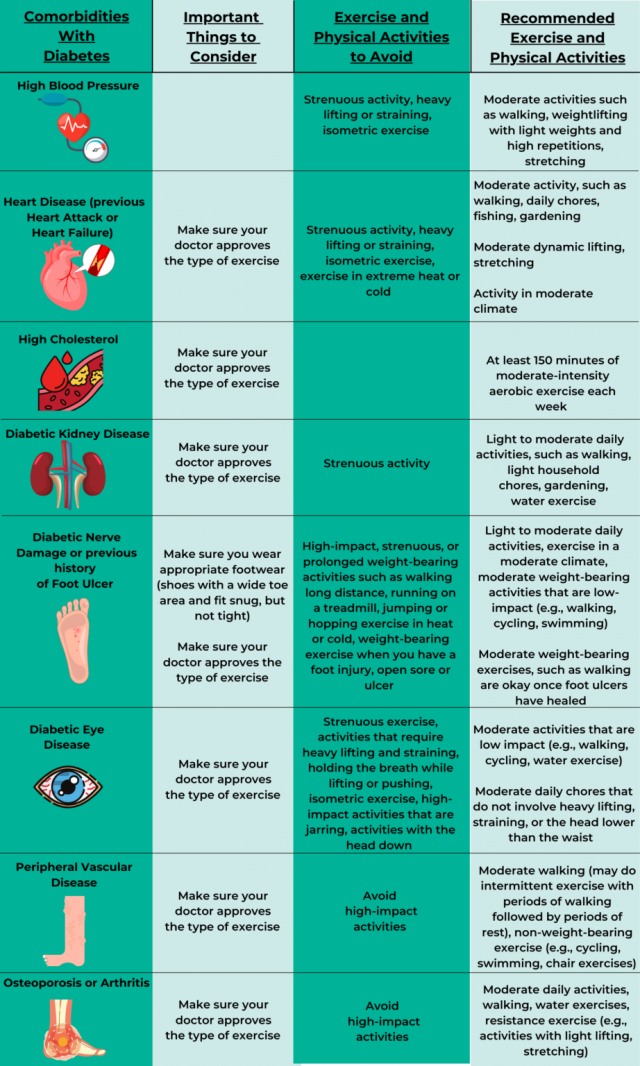Learn how to manage Type 1 and Type 2 Diabetes and Prediabetes using diet and physical activities.
“What should I eat and how much should I exercise?” These are the common questions asked by individuals when they are diagnosed with Type 1 Diabetes, Type 2 Diabetes, and Prediabetes. This article addresses these questions.
Diabetes is a chronic illness causing persistent high blood sugar levels. These high levels can affect virtually all parts of the body causing nerve damage, kidney disease, heart disease, and more. On the other side, extreme blood sugar control can cause low blood sugar level, called hypoglycemia. It is important to balance food intake, physical activity, and medications to ensure that blood sugar level stays in the recommended range, and to avoid hypoglycemic episodes.
Managing diabetes is possible with education, practice, and support from your Dietitian. Some controllable factors are foods and the quantities you eat, level of physical activity, and adherence in taking medications.
The importance of diet in managing diabetes
What you eat and how much impacts the blood sugar level significantly. Making healthy food choices and tracking eating habits are important with your own diabetic diet plan. These keep your blood glucose in check and control heart disease risk factors, such as high cholesterol and high blood pressure. If you don’t watch what you eat, extra calories and fat can cause unwanted increases in your blood glucose.
What should I eat?

There is no diet known as a “diabetic diet”. You should eat the healthiest foods in moderate amounts. Your overall diet should be low in fat and calories and rich in nutrients.
Recommended calorie intake
Age, sex, height, weight, and level of physical activity are determinants of the target calorie number you need to maintain your weight.
General guidelines for calories needed per day to maintain weight:
| MOST MEN | 15 calories/lb. |
| SEDENTARY MEN | 13 calories/lb. |
| MOST WOMEN | 13 calories/lb. |
| ACTIVE WOMEN | 15 calories/lb. |
| SEDENTARY WOMEN | 10 calories/lb. |
| MEN & WOMEN OVER AGE 55 | 13 calories/lb. |
| OBESE MEN & WOMEN | 10 calories/lb. |
| PREGNANT WOMEN | 15-17 calories/lb. |
| LACTATING WOMEN | 15-17 calories/lb. |
A safe rate of weight loss is about 1-2 pounds per week. If you are planning to lose weight at the rate of 1-2 pounds per week, you need to subtract 500-1000 calories from your total calories needed per day to maintain your weight.
Carbohydrates
The target amount of carbohydrates consumed daily for people with diabetes is uncertain. Carbohydrates should come from fruits, vegetables, whole grains, legumes, low-fat milk, and much less from added sugars. A diet that is high in fiber (25-30 grams per day) may help in controlling blood sugar levels.
Fat
People with diabetes are at increased risk of high cholesterol levels, heart disease, and stroke. Quality of fat intake is more important than quantity. Choose monounsaturated and polyunsaturated fats found in fish, olive oil, and nuts over saturated fats and trans-fats.
Proteins
The average daily intake of protein is typically 15-20% of total calorie intake. People with Diabetic Kidney Disease should aim to maintain the recommended daily allowance (RDA) of 0.8g/kg of body weight per day.
Sodium
The recommended sodium intake is usually less than 2300 mg per day (approximately 1 tsp.). A sodium level of 2000mg per day may be better if you have high blood pressure, heart failure, or diabetic kidney disease.
What is carbohydrate counting and why is that important?
Carbohydrates can have a direct impact on blood sugar level. The amount of carbohydrate intake varies person-to-person, and there is no one-size-fits-all amount. Monitoring carbohydrate intake, or “carbohydrate counting”, is an important factor, especially when you are taking insulin.
There should be consistency in the amount of carbohydrates at each meal if you take the same amount of insulin at the same time every day. Eliminating carbohydrates completely is also not healthy because the body requires some carbohydrates each day for proper functioning.
Your dietitian will help you determine the number of carbohydrates needed at each meal and snack time based upon your insulin regimen, typical eating habits, physical activity level, body weight, and nutritional goals. Keep daily records of your food consumption and blood glucose levels. These will help you understand what affects your own blood glucose levels.


One way of counting carbohydrates is to look for the total carbohydrate grams on the packaging labels. To figure out the carbohydrate content of a food’s serving size, simply subtract the number of grams of dietary fiber from the number of grams of total carbohydrates.
You can use this number when counting carbohydrates for your insulin dose.
What kind of exercise is recommended for people with diabetes?
Regular physical activity plays an important role in regulating your blood glucose level. It makes your cells more sensitive to insulin. Regular exercise can help you lose weight and keep it off. Research has shown that the chances of heart disease and premature death are reduced in people who do moderate-intensity exercise for 150 minutes per week, as opposed to people who are sedentary.
Exercise is important even if you are experiencing complications to keep your blood sugar in check and prevent further progression. Talk to your doctor before trying any new kind of physical activity. If you have never exercised before, start off with light activity. Any physical activity is much better than nothing at all.
Exercising with complications and comorbidities

What else is important to know before I exercise?
It is important for people taking insulin or Insulin Secretagogues (medications that increase insulin secretion from the pancreas, such as Sulfonylureas and Glinides) to check their blood sugar level before exercising. These medications can lower your blood sugar level, causing hypoglycemia. You may not always exhibit symptoms of low blood sugar levels. Therefore, it is important to ensure your blood sugar level is not below 100mg/dL (5.6 mmol/L) before and after you exercise.
If your blood sugar is below 100mg/dL, you will need to eat a small snack containing 15-30 grams of carbohydrates before you begin exercising, such as fruit juice, fruit, crackers, or even glucose tablets. If your glucose level is low before exercising, check your blood glucose every 15 minutes while exercising.
If your blood sugar is more than 240 mg/dL, you should not exercise. Call your doctor immediately if your blood glucose stays above 240mg/dL.
Discuss with your doctor ways to exercise safely and manage low blood sugar level while exercising.
The take away
Whether you are managing Type 1 diabetes, Type 2 diabetes, or prediabetes, healthy eating and regular physical activity are crucial for preventing diabetes disease progression. If you have prediabetes, you can prevent or delay Type 2 diabetes by adopting the healthy lifestyle changes mentioned.
For recommended diet and physical activities, eat a consistent number of calories. Consume carbohydrates from healthy food sources, such as fruits, vegetables, and whole grains. Count your carbohydrates if you are taking insulin. Replace all saturated fats and trans-fats with monounsaturated and polyunsaturated fats. Eat less salt and engage in 150 minutes or more of moderate-intensity activities every week.
“There are many ways to love your body, but fueling your body with nutritious food is the highest form of self-respect.”
– Ania Drosnes
“I have high blood sugars, and Type 2 diabetes is not going to kill me. But I just have to eat right, and exercise, and lose weight, and watch what I eat, and I will be fine for the rest of my life.”
– Tom Hanks


